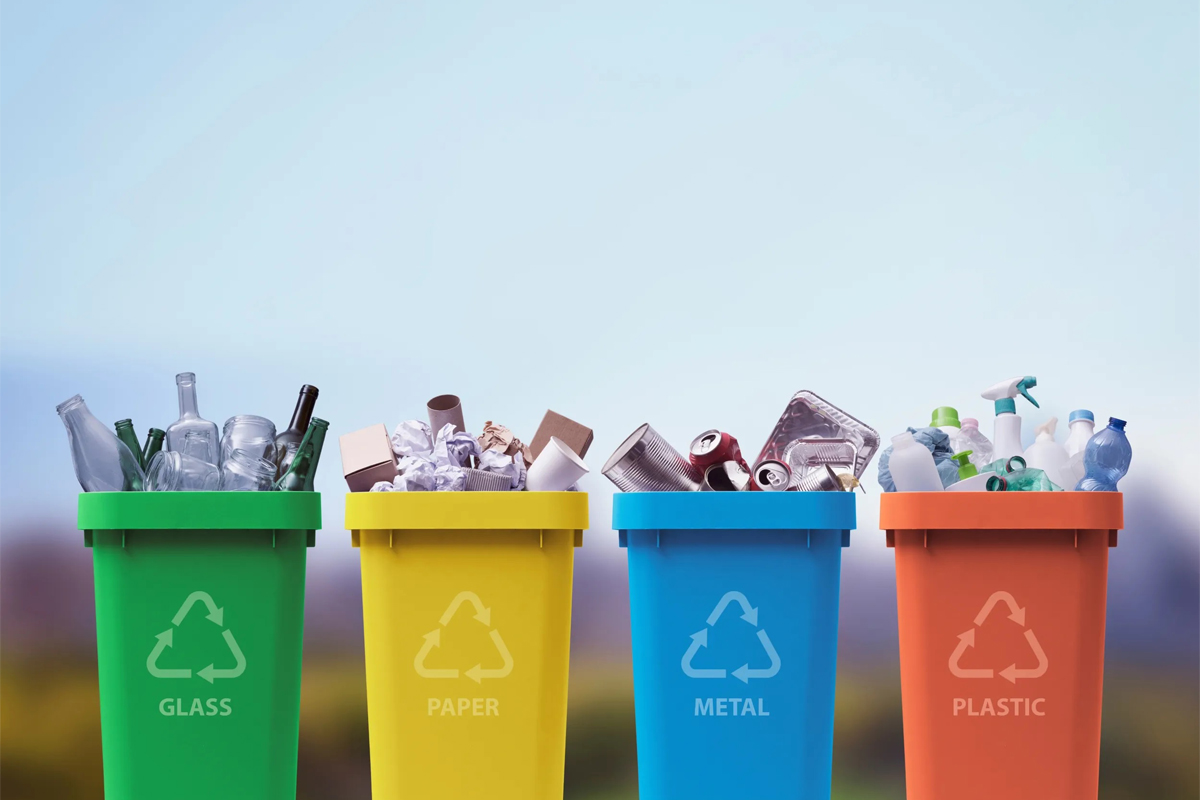النفايات الصلبة في لمحة


ما هي النفايات الصلبة؟
تشير النفايات الصلبة إلى أي مادة تم التخلص منها ولا تكون في صورة سائلة أو غازية. وتشمل مجموعة واسعة من المواد التي لم تعد ضرورية أو مفيدة أو مرغوب فيها وبالتالي يتم التخلص منها. يمكن أن تأتي هذه المواد من مصادر مختلفة مثل المنازل، الشركات، الصناعات، الزراعة، والخدمات العامة.


أنواع النفايات الصلبة:
1. النفايات الصلبة البلدية (MSW):
– النفايات المنزلية: تشمل عناصر النفايات اليومية مثل العبوات، بقايا الطعام، مخلفات الحدائق، الأثاث، الملابس، الزجاجات، والأجهزة.
– النفايات التجارية: تنتج عن الأنشطة التجارية مثل المكاتب، المتاجر، المطاعم، والفنادق. أمثلة تشمل العبوات، نفايات الطعام، الورق، والبلاستيك.
2. النفايات الصناعية:
– النفايات الصناعية غير الخطرة: تنتج عن عمليات التصنيع والصناعات المختلفة. أمثلة تشمل الخردة المعدنية، البلاستيك، الخشب، ومخلفات العمليات الصناعية الأخرى.
– النفايات الصناعية الخطرة: تحتوي على مواد خطرة تتطلب معالجة وتخلصًا خاصًا. الأمثلة تشمل المواد الكيميائية، المذيبات، والمعادن الثقيلة.
3. النفايات الزراعية:
تشمل المخلفات الناتجة عن الأنشطة الزراعية مثل بقايا المحاصيل، السماد، وحاويات المبيدات.
4. مخلفات البناء والهدم:
نفايات ناتجة عن أنشطة البناء، والتجديد، والهدم. مثل الخرسانة، الخشب، المعادن، الطوب، الزجاج، ومواد البناء.
5. النفايات الطبية الحيوية:
تنتج عن المنشآت الصحية مثل المستشفيات، العيادات، والمختبرات. الأمثلة تشمل الإبر، الضمادات، والأدوية.
6. النفايات الإلكترونية (E-Waste):
الأجهزة والمكونات الإلكترونية التي تم التخلص منها مثل الحواسيب، التلفزيونات، الهواتف المحمولة، والبطاريات.


تصنيفات وخصائص للنفايات الصلبة:
– قابلة للتحلل الحيوي:
نفايات عضوية يمكن أن تتحلل بشكل طبيعي، مثل بقايا الطعام، الورق، ومخلفات الحدائق.
– غير قابلة للتحلل الحيوي:
مواد لا تتحلل بسهولة، مثل البلاستيك، المعادن، والزجاج.
– نفايات خطرة:
نفايات تشكل تهديدًا كبيرًا أو محتملًا للصحة العامة أو البيئة، وتتطلب طرق تخلص خاصة.
– نفايات غير خطرة:
نفايات لا تشكل تهديدًا مباشرًا للصحة أو البيئة في الظروف العادية.

إدارة النفايات الصلبة:
تعد الإدارة الفعّالة للنفايات الصلبة أمرًا بالغ الأهمية لتحقيق الاستدامة البيئية وحماية الصحة العامة. من خلال إدارة النفايات الصلبة بكفاءة، يمكننا تقليل تأثيرها السلبي على البيئة وصحة الإنسان، وتعزيز الاستخدام المستدام والفعّال للموارد. لخطوات الرئيسية لإدارة النفايات الصلبة تشمل:
– الجمع:
تجميع النفايات الصلبة من المصادر السكنية، التجارية، والصناعية.
– النقل:
نقل النفايات التي تم جمعها إلى مرافق المعالجة أو التخلص.
– المعالجة والاسترداد:
– إعادة التدوير: تحويل مواد النفايات إلى منتجات جديدة.
– التسميد: تحلل النفايات العضوية لإنتاج السماد لاستخدامه في الزراعة وتنسيق الحدائق.
– التخلص:
– المدافن: دفن النفايات في مواقع مخصصة مصممة لتقليل الأثر البيئي.
– منشآت تحويل النفايات إلى طاقة: تحويل المواد غير القابلة لإعادة التدوير إلى حرارة أو كهرباء أو وقود من خلال عمليات مختلفة.

مولدو النفايات الصلبة التجاريين في الأردن

مولدو النفايات الصلبة التجاريين في الأردن يشمل جميع مولدي النفايات الصلبة في القطاعات التجارية وغير السكنية في الأردن ، بما في ذلك:
– القطاع التجاري.
– الشركات الخاصة.
– المصانع/منشآت التصنيع.
– المؤسسات العامة (مثل المباني الحكومية، المدارس/الجامعات العامة، السفارات الأجنبية، المستشفيات العامة).
– المجتمع المدني.
– المزارع الحضرية وشبه الحضرية.
– النفايات الطبية الناتجة عن المستشفيات، والصيدليات، والمكاتب الطبية.

الوضع في عمّان:

يستقبل مكب الغباوي يوميًا حوالي 3,200 طن من نفايات عمّان، حيث يُقدّر أن 40% منها على الأقل تأتي من القطاع التجاري وفقًا لتقديرات أمانة عمّان الكبرى.
ومع ارتفاع معدلات إنتاج النفايات في عمّان بأكثر من 5% سنويًا، تشير التقديرات المتفائلة إلى أن معدل إعادة التدوير في عمّان لا يتجاوز 7%، وهو معدل منخفض مقارنة بالمدن الأخرى في المنطقة.
لا يزال مولدو النفايات يفضلون التخلص منها في المكبات، ويواصل المصنعون استخدام المواد الخام البكر نظرًا لتكلفتها المنخفضة وسهولة الحصول عليها مقارنة بالخدمات الحالية لإعادة التدوير.

ما المدة التي تحتاجها النفايات لتتحلل؟

تختلف مدة تحلل المواد بشكل كبير بناءًا على الظروف البيئية مثل درجة الحرارة والرطوبة، ووجود الكائنات الدقيقة. يساعد فهم المدة اللازمة لتحلل المواد المختلفة على تسليط الضوء على أهمية إعادة التدوير والإدارة السليمة للنفايات.
المواد التي تستغرق مئات أو آلاف السنين للتحلل قد تسبب أضرارًا بيئية طويلة الأمد، مما يجعل تقليل النفايات، وإعادة الاستخدام، وإعادة التدوير أمرًا بالغ الأهمية للحفاظ على البيئة.

مفهوم المبادئ الثلاثة (3R's):

يشكل مفهوم المبادئ الثلاثة (التقليل، إعادة الاستخدام، إعادة التدوير) أساسًا في إدارة النفايات وحماية البيئة، ويهدف إلى تقليل النفايات وتعزيز الممارسات المستدامة.
تعد هذه المبادئ ممارسات أساسية لإدارة النفايات وتعزيز الاستدامة البيئية. ومن خلال دمج هذه المبادئ في الحياة اليومية، يمكن للأفراد والمجتمعات تقليل تأثيرهم البيئي بشكل كبير، والحفاظ على الموارد، والمساهمة في كوكب أكثر صحة.

لماذا إعادة التدوير مهمة؟
تلعب إعادة التدوير دورًا أساسيًا في حماية البيئة، والحفاظ على الموارد، ودعم التنمية المستدامة. فيما يلي الأسباب الرئيسية لأهمية إعادة التدوير:
1. حماية البيئة:
– تقليل التلوث: تساعد إعادة التدوير على تقليل تلوث الهواء والماء من خلال الحد من الحاجة إلى أساليب التخلص التقليدية مثل الحرق والطمر.
– الحفاظ والتقليل من مساحة المكبات: من خلال تحويل النفايات بعيدًا عن المكبات، تقلل إعادة التدوير من الحاجة إلى مساحات إضافية للتخلص من النفايات وتمنع إنشاء مكبات جديدة قد تسبب تدهورًا بيئيًا.
2. الحفاظ على الموارد:
– حماية الموارد الطبيعية: تعمل إعادة التدوير على الحفاظ على الموارد الطبيعية مثل الأخشاب والمياه والمعادن من خلال إعادة استخدام المواد بدلاً من استخراج موارد جديدة.
– توفير الطاقة: يتطلب تصنيع المنتجات من مواد معاد تدويرها طاقة أقل مقارنة بتصنيعها من مواد خام. على سبيل المثال، يوفر إعادة تدوير الألمنيوم ما يصل إلى 95% من الطاقة اللازمة لإنتاجه من خام البوكسيت.
3. الفوائد الاقتصادية:
– خلق فرص عمل: تساهم صناعة إعادة التدوير في خلق وظائف في مجالات متعددة مثل جمع ومعالجة وتصنيع المواد.
– تشجيع الابتكار: تعزز إعادة التدوير من تطوير تقنيات ومنتجات جديدة، مما يدعم الابتكار والنمو الاقتصادي.
4. التخفيف من تغير المناخ:
– خفض انبعاثات الغازات الدفيئة: تساعد إعادة التدوير على تقليل الانبعاثات من خلال تقليل استهلاك الطاقة المرتبط باستخراج ومعالجة المواد الخام، مما يساهم في مكافحة تغير المناخ.
5. الاستدامة:
– تعزيز الاقتصاد الدائري: تدعم إعادة التدوير مبادئ الاقتصاد الدائري حيث تُستخدم المنتجات والمواد لفترة أطول، مما يقلل من النفايات ويعزز الإنتاج والاستهلاك المستدامين.
– تشجيع الاستهلاك المسؤول: من خلال إعادة التدوير، يصبح الأفراد والشركات أكثر وعيًا بأنماط استهلاكهم، مما يحفز الخيارات البيئية المسؤولة.
6. الصحة العامة:
– تقليل النفايات الخطرة: تساهم إعادة التدوير والتخلص السليم من المواد الخطرة مثل البطاريات والإلكترونيات في منع تسرب المواد الضارة إلى البيئة وحماية الصحة العامة.
7. تعزيز المجتمع:
– فرص تعليمية: غالبًا ما تتضمن برامج إعادة التدوير مكونات تعليمية تزيد من الوعي بالقضايا البيئية وتعزز المشاركة المجتمعية.
– تعزيز الروابط المجتمعية: تساهم المبادرات المجتمعية لإعادة التدوير في توحيد الأفراد وتعزيز روح المسؤولية الجماعية وروح التعاون داخل المجتمع.


إعادة التدوير والاقتصاد الدائري
إعادة التدوير والاقتصاد الدائري هما مفهومان مترابطان يهدفان إلى إنشاء نموذج اقتصادي مستدام. يسعى الاقتصاد الدائري إلى إعادة تعريف النمو بالتركيز على الفوائد الإيجابية للمجتمع ككل، مع فك الارتباط بين النشاط الاقتصادي واستهلاك الموارد المحدودة.
تلعب إعادة التدوير دورًا محوريًا في هذا النموذج من خلال تحويل النفايات إلى موارد قيّمة، مما يقلل من التأثير البيئي ويعزز التنمية المستدامة.

ما هو الفصل من المصدر (SAS)؟
الفصل من المصدر هو عملية جمع وفرز النفايات في النقطة التي يتم فيها إنتاجها. تهدف هذه العملية إلى تحسين عملية إعادة التدوير وتقليل كمية النفايات التي تنتهي في مدافن النفايات. خلال هذه العملية، يتم فصل المواد القابلة لإعادة التدوير مثل الورق والبلاستيك والمعادن عن النفايات الأخرى في المصدر.



تعزيز ممارسات إعادة التدوير
إعادة التدوير هي عنصر حيوي في الحفاظ على البيئة والتنمية المستدامة. فهي تقدم العديد من الفوائد، بدءًا من تقليل التلوث والحفاظ على الموارد وصولاً إلى خلق فرص عمل والتخفيف من تغير المناخ. من خلال تبني وتعزيز ممارسات إعادة التدوير، يمكننا المساهمة في كوكب أكثر صحة ومستقبل أكثر استدامة.

